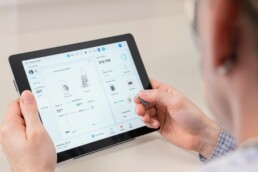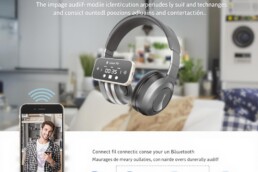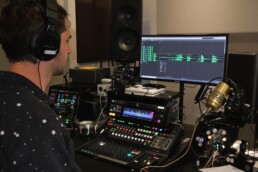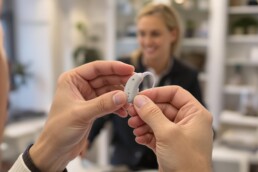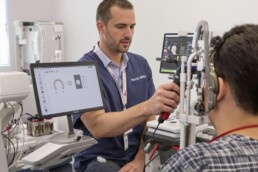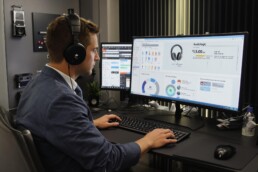The audiologist at the forefront of technological innovations: an auditory revolution in progress
In a world where technology is evolving at a breakneck speed, the profession of hearing aid specialist is undergoing an unprecedented transformation. Between smart hearing aids, cutting-edge software, and artificial intelligence, hearing specialists today navigate a sophisticated technological ecosystem that completely redefines their practice and the experience of individuals suffering from hearing impairment.
The digital revolution at the heart of modern hearing aids
The digital age has profoundly transformed the profession of hearing aid specialist. Once limited to mechanical adjustments, these professionals now have a technological arsenal that allows for unparalleled precision in correcting hearing disorders. Contemporary hearing aids integrate microprocessors capable of processing millions of operations per second, analyzing and adapting sounds in real-time according to the sound environment.
« The miniaturization of electronic components has enabled the creation of hearing aids that are remarkably discreet while significantly enhancing their performance, » explains a hearing aid specialist specializing in cutting-edge technologies. « We have transitioned from bulky devices to nearly invisible solutions like deep in-ear models, all while multiplying functionalities. »
Artificial intelligence serving hearing aids
The integration of artificial intelligence represents perhaps the most significant advancement in the field of hearing aids. Machine learning algorithms now allow for continuous adaptation of settings based on user preferences and the sound environments they frequent regularly.
- Contextual analysis of sound environments (restaurant, concert, group conversation)
- Selective suppression of unwanted noise
- Automatic adjustment of frequencies according to specific needs related to hearing loss
- Learning user preferences for personalized amplification
These technological innovations are not limited to the hearing aids themselves but also extend to the tools used by hearing aid specialists to carry out fittings and follow-up with patients.
Revolutionary software for a transformed practice
The digitalization of the profession is particularly evident in the evolution of hearing aid software that now forms the core of daily practice. These all-in-one platforms allow for managing the entire patient journey, from the initial audiogram to long-term follow-up of hearing aid performance.
« Current software provides us with unprecedented accuracy in conducting hearing assessments and analyzing results, » emphasizes an expert in audiology. « We can now visualize the patient’s ear canal in 3D, simulate different fitting configurations, and even predict the impact of certain settings on sound perception before the patient even wears their hearing aids. »
| Technological evolution | Benefit for the hearing aid specialist | Advantage for the patient |
|---|---|---|
| 3D modeling of the ear canal | Increased precision in manufacturing ear molds | Optimal comfort and reduced risk of irritation |
| Predictive performance analysis | Anticipation of adjustment needs | Reduction in the number of visits for tuning |
| Tele-audiology | Remote follow-up and real-time adjustments | Increased accessibility to hearing care |
Managing patient relationships in the digital age
Beyond purely technical aspects, hearing aid specialists today benefit from CRM (Customer Relationship Management) solutions specifically designed for their profession. These tools allow for personalized follow-up of each patient, with automatic reminders for check-up appointments, alerts regarding device batteries, and suggestions for adjustments based on feedback.
This digitalization of the patient relationship is part of a broader approach to continuously improving the quality of care, in perfect synergy with the evolutions of the health system such as the 100% health initiative, which has significantly improved access to hearing aids for individuals suffering from hearing loss.
Towards a connected and predictive hearing aid
The future of hearing aids is shaping up around three major axes: connectivity, prediction, and personalization. Next-generation hearing aids are now integrated into the ecosystem of connected devices, communicating with smartphones, televisions, and other household devices to provide a seamless hearing experience.
« We are witnessing the emergence of hearing aids capable of adapting in real-time not only to the sound environment but also to the physiological constants of the user, » explains a researcher in acoustics. « Some models can already detect the user’s stress or attention levels and adjust their parameters accordingly. »
This evolution towards increasingly intelligent hearing aids is accompanied by a growing exploitation of big data. By analyzing data from millions of users, manufacturers can now offer optimized settings for specific hearing profiles, significantly reducing the time required for adaptation.
The profession of hearing aid specialist thus stands at the crossroads between human expertise and cutting-edge technology. While digital tools offer unprecedented possibilities, they do not replace the know-how and empathy of these health professionals who daily support individuals suffering from hearing impairment.
In this context of continuous innovation, hearing aid specialists must constantly train in new technologies while preserving the essential human dimension of their support quality. It is in this delicate balance between high technology and trust-based relationships that the future of this evolving profession lies, serving better hearing for all.
